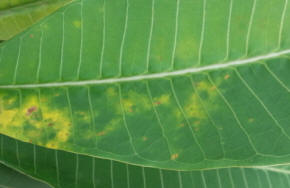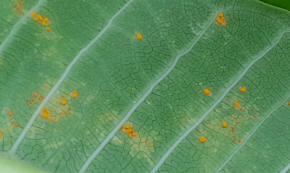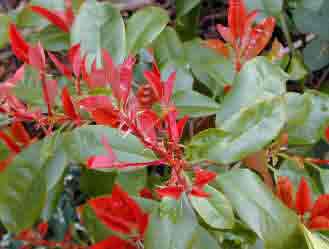Rust Spots on Leaves - Rust Disease on Plants
Rusts on plants are caused many different types of fungus infections. All plant leaf rusts are fungal growths and as such can be treated or even prevented in several different ways. Most plant rusts are specific to a particular type or family of plants. For instance, the rust that affects bedding geraniums - Pelargoniums - is different to that which affects Antirrhinums.
Some rusts are happy to spend their entire life cycle on their chosen plant, others have more complicated life cycle, and need to spend part of their lives on a totally unrelated plant species, which incidentally, they rarely affect. An example being some of the rusts that affect members of the rosacea family, also need to live part of their life cycle on members of the Juniper group of conifers, where they rarely do lasting damage.
In simplistic terms, they use the Junipers for a breeding home, then go off to feed on the mentioned garden plants and trees. (Not biologically correct, but purely an insight to the life cycle.) Pear Tree Rust – members of the Rosacea family - is one that also requires a Juniper sub-host for part of its life cycle.



Upper side of mildly affected leaf with rust spot symptoms | Lower
side of leaf showing the rust pustules | Severely affected leaf.
Rust spots on leaves are the most common infestation, though some rusts also affect stems of plant or flowers. Rarely, some rusts can be attracted to flowers or fruit. It is not unusual to see the same rust pustules spreading along the leaf petioles and - somewhat rarer - to the stems also.
Visible symptoms of Rust
Whilst the collective name of 'rusts' describes most types, being rusty brown/orange in colour, there are also white, pink, red, yellow and black rusts. Most leaf and stem rusts are brown. Leaf spot rusts almost always live on the undersides of leaves, but are generally noticed on the upper side of the leaf as yellow - or otherwise discoloured - spots. If not dealt with, the isolated spots spread and can soon affect the whole leaf, even to the extent of harming the general plant health, or in some instances killing the plant.
The actual rust pustules under the leaf are the business side of things. The spots on the upper surface, are the result of the rust fungus 'feeding' on the plant. The pustules under the leaf are basically groups of miniscule spores, waiting to be spread to other parts of the plant or neighbours, or back to the other half of their chosen life cycle hosts. Place an affected leaf on a clean sheet of white tissue paper and you will see the find powdery spores. Be careful not to spread the disease in doing so! By using tissue rather than smooth paper, you are confining the spores. They can easily be blown from smooth paper.
Some rusts develop within the leaf, and whilst the upper surface still has the tell tale spots, the rust pustules do not show on the lower surface.
Spread of Rusts.
All common plant and leaf rusts are easily transported by air currents, or even mild disturbance around some plants. They are happiest in damp weather, and in particular follow on after a wet cold spring or early summer. All common plant rusts require wet foliage for relatively long periods to become active. Very different to the other leaf fungal disease of powdery mildew, which needs dry conditions. Flying insects and also carry the rust fungus spores on their bodies or wings. as with the rusts, many insects are plant specific at certain time of the year, so inter plant infection can be rapid.
How to prevent rust.
Plant those varieties which are rust resistant.
If you dig deeper, you can prevent rust to a large degree by not planting two host types close together. For instance if you are prone to the rusts that affect apples and other rosacea shrubs and trees, then Juniper planting would be a no-go.
How to control rust spots – General Control
It is often advocated that affected leaved be removed and disposed of. In small numbers of local infection, this may be a possible course of action, though with the risk of further spreading of the rust spores. If this is deemed necessary, then carefully pick off the affected leaves into a plastic bag.
Do NOT compost or otherwise live-dispose of any affected leaves. Burn!
At the end of season, remove all plant debris from around the plant, and burn.
Good overall plant health is one of the best methods of prevention or control, and feeding with a good general fertiliser to ensure this is desirable.
Late developing rusts, are rarely anything other than unsightly, for they are too late in the season to effect damage to the plant overall. If you are prone to these types of rusts, then take preventative measures earlier in the growing season as a precaution and preventative. Trees are normally affected by the later rusts, and for all manner of reasons any chemical or other control is rarely practicable.
Chemicals for Control of Rust.
Fungicides with a copper base may be used with all fruit and ornamental crops. Bordeaux mixtures or specific fruit and vegetable ‘disease’ (NOT PEST) control sprays/fungicides.
Some chemical are specifically for use on ornamental and NOT edible crops. It is far better to use ‘fruit and vegetable’ sprays for all applications.
Do not use multi-purpose sprays for pests and diseases. No need to kill insects if you have a disease problem (rust!)
Popular Plants Affected include
Allium – all types, ornamental or edible vegetables; Antirrhinums; Pelargoniums; Chrysanthemums – all types; Alcea – Hollyhocks – notorious; Hypericum shrubs – all types; Vinca – minor and major types; Mahonias – the aquifolium types; Pear Rust – increasingly so; Roses – often fatal, though rare; Leeks – notorious; Lawn and ornamental grasses:
Best Selling Gardening Products
Popular Gardening Sections

Problems
Identify Weeds in The Garden - How to deal with weeds. Diseases and Pest which harm your garden and plants, learn how to prevent, deter and erradicate your garden problems.
Garden Problems
Pruning
Pruning Guide. Shrubs flower better with correct pruning. Many illustrations and examples of what to do - and when. Includes evergreens, roses, flowering shrubs, spring flowering shrubs and pruning for stem effect. This is our most viewed and comprehensive section,
Pruning
Gardening Businesses
Gardening Businesses listed in the UK counties and USA states. County and State Listings of businesses involved in Garden supplies and services. If you wish to be added to the Directory, please send us your information. Having problems, use the search box
Businesses
Gardening
In this section you will learn about Gardening Basics, Containers, Landscaping, Propagation and Soil.
Gardening
Gardening Gifts
Gardening Gifts and Reviews, Read Before you Buy
- Gardening Gifts Ideas
- Gifts For Her
- Gifts For Men
- Power Tool Gifts
- Cheap Gifts
- Personalised Gifts
- Wildlife Gifts
- Family Gifts



